There are many varieties of Poker, which all developed from an earlier game called Bluff (The Key 102). It would take a long time to describe all the forms of Poker, so I've decided to just give the rules for Draw Poker. Draw Poker was played after 1845, and possibly even before then (McCutcheon 194).
Draw Poker has variations, but I'm just giving some very basic rules here. The strategies can also be very complex (there are entire books about it), but I'm just going to mention a few basic points to help beginners get started. I'm not a card shark, but I'll give you some suggestions to help you get started if you're new to the game, and you can look up more about strategy if you're interested later. The better you are at mathematics (especially estimating probability) and the better you are at controlling your features and judging the emotions of others, the better you'll be at this game.
Although Poker is a gambling game, it doesn't need to be. I've played it with friends without even using poker chips, just declaring the person with the highest-ranking hand the winner of each round. Some people like to use candy or other snack foods as the stakes. The advantage of betting is that it extends the time of the game, allows for more complex strategy, and adds an element of suspense. But, the most important part is that the way you play allows you and your fellow players to have fun. I recommend keeping the game friendly and not gambling with real money. If you've decided not to bet at all, even with poker chips or other markers, just follow the directions for the game, skipping all the ante and betting phases.
If you would like to learn more about other poker variations, I recommend:
Draw Poker
The rules for this game come from Hoyle's Rules of Games ed. by Morehead and Mott-Smith, pp. 75-84, with some further information from The Way to Play by the Diagram Group, pp. 230-231. Don't let the length of the rules bother you! This is one of the longest sections in the site, but the basic concepts are actually not that difficult.
Players: 2 to 8 people. (It's best to aim for a group of about 5 to 8, but the game is flexible enough that you don't have to stick to that. It can be played with only two players, but it's better with more.)
Object: To get a hand of cards with a higher rank than the other players' hands (see the Order of Hands below) and to win more poker chips.
The Deck: A regular 52-card deck. (You may keep the jokers in the deck if you want to use them as wild cards. Otherwise, remove them.)
Other Equipment: Poker chips or similar markers to use as stakes.
Poker chips typically come in three colors: white, red, and blue. The white chip is worth the least, and is considered the basic unit of the game. (You can think of it as being worth "one" -- one what isn't very important, unless you're gambling for real money.) Red chips are worth five of the white ones, and blue chips are worth ten. If you're using anything other than standard poker chips (like food, pieces of colored paper, etc.), make sure that everyone knows and agrees on the relative values before you begin. (Ex. Are marshmallows worth more than peanuts, and is there any difference in value between different colors of marshmallows? These are important issues!) If using edible markers, be aware that if you eat them during the game, you might not get replacements (depending on your supply). If you run out of standard poker chips while playing, the rules allow you to purchase an additional set from the player acting as banker for the game, but that depends on the arrangement you make with your fellow players.
Things to Consider Before Playing: Before the game begins, discuss the rules, the amount of chips or markers each player will have, and what you'd like to do if someone runs out (allowing players new sets of chips if they run out extends the game, and poker games can take hours). Consider whether there's a time limit on how long you're going to play or if you want to limit the game to a certain number of hands. You should also decide whether or not there is a limit on the size of the bets (there can be a minimum or a maximum bet, and people often have both) or the amount of chips allowed in each pot. If you are using any wild cards, you should name them now.
For beginners, I recommend keeping things as simple as possible. If you've never played before, I recommend just dividing up your markers (the contents of your box of poker chips or whatever you're using) evenly between your players, setting aside any extra. Do not bother with setting up a banker or giving people more chips if theirs run out. Instead, just focus on setting a time limit or a certain number of hands to play to give yourself a good feel for the game (maybe play for about an hour). Whoever has the most chips at the end of that period is the winner of the game. For the minimum bet, I suggest one white chip, and for the maximum, I suggest one blue chip. Having a 1 to 10 range in betting can help you when deciding how much to bet each time. To put it another way, on a scale from 1 to 10, how likely do you think you are to win the pot with the hand you're holding? (We'll discuss that more later, and these are only suggested amounts for beginners. You can always set your own.) I also recommend not using wild cards, at least for the first couple of hands, and focus on learning the basic poker hands and their relative values. Wild cards can increase your chances of winning by giving you more options to form a good hand, but it also means that you have to keep track of which cards are the wild cards. It might be best to keep things simpler when you're first learning the game.
Wild Cards: Using wild cards is optional, but if you want to use them, you should declare what is wild at the beginning of the game, before the cards are dealt. A card that is a wild card can count as any other card in the game, both in value and suit, as the player holding it wants to use it. The most common cards to use as wild cards are jokers and deuces (twos), but the players can declare any type of wild cards they like. When judging the value of a hand, the wild cards are worth exactly what they are declared to be. (In other words, a joker that has been declared to be an ace in someone's hand is worth as much as any regular ace in anyone else's hand.) Other than a Five of a Kind hand (see Order of Hands below), a player should not declare a wild card to be a duplicate of a card already in their hand. (For instance, there is no such thing as a "double-ace-high" flush.)
Phases of the Game: Draw poker follows a set pattern of phases which repeat with each hand of the game. Players begin each hand with an ante before the cards are dealt. Then, each player is dealt a hand of five cards. There is a betting period after the deal, followed by an opportunity for the players to discard some of their cards and draw new ones in exchange. There is another betting phase after the draw phase, and finally, a showdown of the players' hands to determine the winner (the Diagram Group 230).
The Ante: The players all start with an equal number of poker chips (or whatever you want to use as a marker in betting). Before the cards are even dealt, each player puts one white chip (or the lowest value marker that you're using) in the middle of the table to start the pot, the collection of chips that the player with the highest-ranking hand will win.
The Deal: The traditional way to choose the first dealer of the game is to have one player (any player) hand out cards face up to everyone until someone gets a jack. From there, the dealer for each new hand will be the person to the left of the last dealer. The dealer for the hand deals out five cards to each player, one at a time, in a clockwise direction.
Once each player receives his cards, he examines them and tries to judge their strength. Have a look at the Order of Hands below. Consider whether you have one of the hands described or if you're lacking maybe only one or two cards to make one of the higher-value hands. (You'll have a chance to change out cards later during the draw phase of the game. If you've played Yahtzee before, it's the same concept as deciding which dice to reroll to get certain combinations.) Your estimation of the value of your hand is important when you decide how much you're going to bet.
Poker Face: As you consider your hand, try to show as little emotion on your face as possible (the classic blank "poker face"). If you have a very good hand, you don't want to give it away by smiling because the other players will be reluctant to add more chips to the pot, thinking that you might have the best chance of winning. If you have a weak hand with little hope of improving it, you don't want to give it away, either. You might later be able to bluff the other players into thinking that your hand is better than it really is. But, while you try to give away as little of your feelings as possible, take a look around the table and see if you can spot signs from others that might tell you how they're feeling about their hands. It could make a difference in your strategy.
Betting (First Round): The first person to bet will be the person sitting to the left of the dealer, and then each other player will take a turn moving clockwise around the table. The amount that each person bets depends on the minimum and maximum bets that the players have agreed on (if they've established limits) and how strong their hand is (how likely the player thinks he is to win against the other players' hands).
The first player who has the option of betting can either place a bet or check. Basically, a check is "a bet of nothing." A player who checks is standing by, doing nothing, waiting to see what the other players will do before making an actual bet. If the first player checks, the others also have an option to check until someone finally makes an opening bet. Once someone makes a bet by putting a chip or chips into the pot, each other player has only one of three options:
- Drop: This is also called "passing." Players can do this at any time during the game, not just on their turn. If a player decides that he has no chance of winning the pot and isn't willing to risk any more chips in it, he puts down his cards. He makes no further bet, and he cannot win the pot now. Any chips that he has already placed in the pot remain there and will be given to the one who wins the pot.
- Call: The player adds just enough chips to the pot to stay in the betting and keep his chances of winning the pot. All players' bets must equalize in the end, which means that each person who wants to stay in must put in as many chips as the player who has put in the most during the round of betting. Any player who is not willing to put in this amount must drop. (This is where bluffing helps. If you raise the bet enough to make the other players lose confidence in their ability to win and drop, you win, even if you actually had the worst hand.)
- Raise: When a player raises, he puts in the minimum amount required to stay in the round plus however many more he wants to add (up to the maximum limit the players have agreed upon). The total amount of his bet (the old minimum plus the extra he added) becomes the new minimum that every player after him must put in the pot in order to stay in the round, although they have the option to raise it further, if they wish. Any player who doesn't want to pay the new amount must drop. When the betting comes around to someone who has already put chips in the pot, they can call by adding the difference between their previous bet and the new one (so the bets equalize) or raise by adding even more on top of that amount.
As each player makes a bet, calls, raises, or drops, he says what he's doing aloud to the other players, so they can keep track of who is still in and what the current bet is. The round of betting is over once every person has put exactly the same amount of chips in the pot so that everyone's total bet is equal. (That means that all of the other players have called or dropped since the last person raised.)
Betting Example: Suppose that there are four people playing: Harry, John, Rose, and Martha. A round of betting between them might go something like this:
Harry (first player): I bet two. (He adds two white chips to the pot as the opening bid.) John: I raise one. (He adds three white chips to the pot -- the minimum two he needed, plus one. Everyone else has to bet at least three to stay in now.) Rose: I raise two. (She adds a red chip to the pot -- the minimum three she needed plus two more. The minimum to stay in is five now.) Martha: I drop. (She puts down her cards because five is more than she wants to bet.) Harry: I call. (He adds four white chips to the pot because he already put in one at the beginning. His total bet is now five, meeting the minimum to stay in.) John: I drop. (He would have needed to put in two more chips to stay in, but he's decided that he doesn't want to do that. The chips he already bet stay in the pot, but he's out of the round.)
The round of betting is now over because the turn has come back around to Rose, the last person who raised, and the only two players left in the round (Harry and Rose) have both put in an equal amount of chips (five). A round can last much longer than that, depending on the number of players and how many times they raise.
As a general tip, if you have a really good hand at this point in the game, it would be a good idea not to go overboard with raising the bet right away. You want to win as many of your opponents' chips as possible, but if you suddenly put in the maximum bet right at the beginning of the game, your oppoents will assume that your hand is so strong that they can't possibly win and will drop out without adding anything to the pot. So, you can raise the bet to win more chips off of the others, but keep it moderate enough that they are willing to stay in the round of betting for as long as possible, contributing even more to the pot.
The Draw: Now that the first round of betting is over, all of the players who are still in the game (those who haven't dropped), have the chance to turn in some of their cards for new ones (any number of them). If a player is happy with his hand as it is, he doesn't need to exchange any of his cards, but all of the players have the option to do so, starting with the one to the dealer's left and moving clockwise around the table. Any player who wants to exchange cards lays the cards he wants to discard face down, and the dealer hands him the same number of cards from the top of the deck.
How many cards do I exchange? That depends entirely on what your hand currently looks like. Remember that your goal is to form one of the hands listed below in Order of Hands, and you want the value of your hand to be as high as possible. If you've played Yahtzee before, these types of exchanges will be familiar, like the rerolls you're allowed on the dice, and you want to make best use of them. This is where mathematics come into the game, figuring out how likely you are to improve your hand and the best way to do it. You don't want to whip out a pencil and paper and do any complex figuring, but you can kind of think it out in your head. There's also an element of psychology involved, because you don't want to let the other players know what kind of hand you have or what you're going for.
Sometimes, it's obvious what to do. A person who already has a really good hand, like a Full House, a Four of a Kind, or a Royal Flush doesn't want to ask for any cards at this point because his hand is already good, and he won't want to mess it up by changing anything. The other players will notice if someone doesn't ask for any cards and will assume that person must have a good hand (although that may not be true), but they won't be able to tell exactly how good. People whose hands aren't very good will lose confidence in their ability to win and may drop out, thinking that they have no chance, and people with good or moderately good hands will probably stay in to see how their hands measure up against the other person's.
Now, suppose that you have only a single pair of tens in your hand. A Pair is better than nothing, but you could make that hand even better by exchanging your three non-tens for three new cards. The hope is that at least one of the new cards that you get will be another ten, giving you a Three of a Kind, or if you're really lucky, a Four of a Kind. Asking to exchange all three of your non-tens maximizes your changes of that happening (and the odds of it working are even higher if you're playing with wild cards because you have more options to help you than just hoping you'll get at least one of the remaining two tens). Of course, you may not get any tens at all, and you may be left with just the Pair, but it's worth trying. Your opponents will know that you weren't satisfied with your hand before, but they have no way of knowing what you have now. It might be something good, but maybe not.
For another example, suppose you were holding the ten of spades, jack of spades, queen of spades, king of spades, and the three of hearts. You almost have a Straight Flush, perhaps even a Royal Flush, minus one card. It's obvious that you should turn in the three of hearts, and you're hoping that you'll get either the nine of spades, or better yet, the ace of spades. You're banking on only one card, but even if you don't get one of the two cards you're really hoping for, things could still turn out well if you get any of the other spades cards because you'll still have a Flush, or if you get a nine or an ace in any suit, you'll still have a Straight. In other words, there are several ways this could go right for you.
So, you see how you can make use of exchanges when there is an obvious hand or a range of hands that you're aiming for. The problem is, what to do when it's not obvious at all. Suppose that you don't have anything that looks like the beginnings of a Straight (no values in order), no matching Pairs, and no collection of a particular suit. What do you do? There are several options, but I'll give you a few suggestions:
- You could turn in your entire hand and ask for a new one, but that wouldn't guarantee that you would get anything good (although it might happen).
- You could keep the highest-ranking card in your hand, turn in the other four, and see if you can get a Pair or better from that. You could even keep the two highest-ranking cards and try for a Pair among those (not a bad option if you have two face cards or an ace and a face card).
- You could try to aim for a Flush, but what do you think the odds are that all the cards you would have to get in order to do that would be the suit that you need? Aiming for a Pair might be more practical because you'd only need to get one card right among three or more to pull it off, but that depends on your hand. There are more cards of each suit in the deck than there are of any particular value of card. Considering what you have, which strategy is more likely to work for you?
Keep in mind that your opponents will note how many cards you ask for. If you ask for a lot, they'll know that your hand was very weak at the beginning and might still be (although they can't be sure what you'll get during the draw). If you ask for only three cards, they might assume that you had at least a Pair at the beginning, although that might not be true. If the draw doesn't help you improve your hand, you could decide to drop and not risk any more of your chips. On the other hand, you can try a completely different strategy and attempt to bluff the other players into thinking you have a very good hand. If you want to do this, ask for only one card or no cards at all. Try to maintain your poker face, but behave with confidence.
Betting (Second Round): The second betting phase follows the same pattern as the first one. The only difference is that all players can check during this betting phase. If they do, the betting phase ends, and the players go right to the showdown. The showdown also begins if all of the bets are equalized (like the end of the first betting phase). If all of the players except one drop out, there is no showdown phase, and the lone remaining player wins the pot without having to show anyone his cards (the Diagram Group 231). (That is the ideal goal of a player who has been bluffing with a weak hand.)
The Showdown: This is where the players remaining in the game finally show each other their hands and compare their values to determine the winner. The winner, the player with the highest-ranking hand, receives the pot. For the next hand of the game, players will have to ante more chips to create a new pot. The overall winner of the game after multiple hands is the player with the most chips.
Order of Hands
The possible hands in a poker game are listed in order from the highest to the lowest ranking. When two or more people have the same type of hand, the winner is the one with the highest-value cards. The card values, from highest to lowest are: ace, king, queen, jack, 10, 9, 8, 7, 6, 5, 4, 3, and 2. However, Aces can be the highest-ranking cards or the lowest-ranking, depending on how you want to use them in forming hands. (Ex. If you have ace, two, three, four, and five, it counts as a straight with ace equal to one. However, aces can also be the next-highest card above kings, so 10, jack, queen, king, and ace also form a straight.)
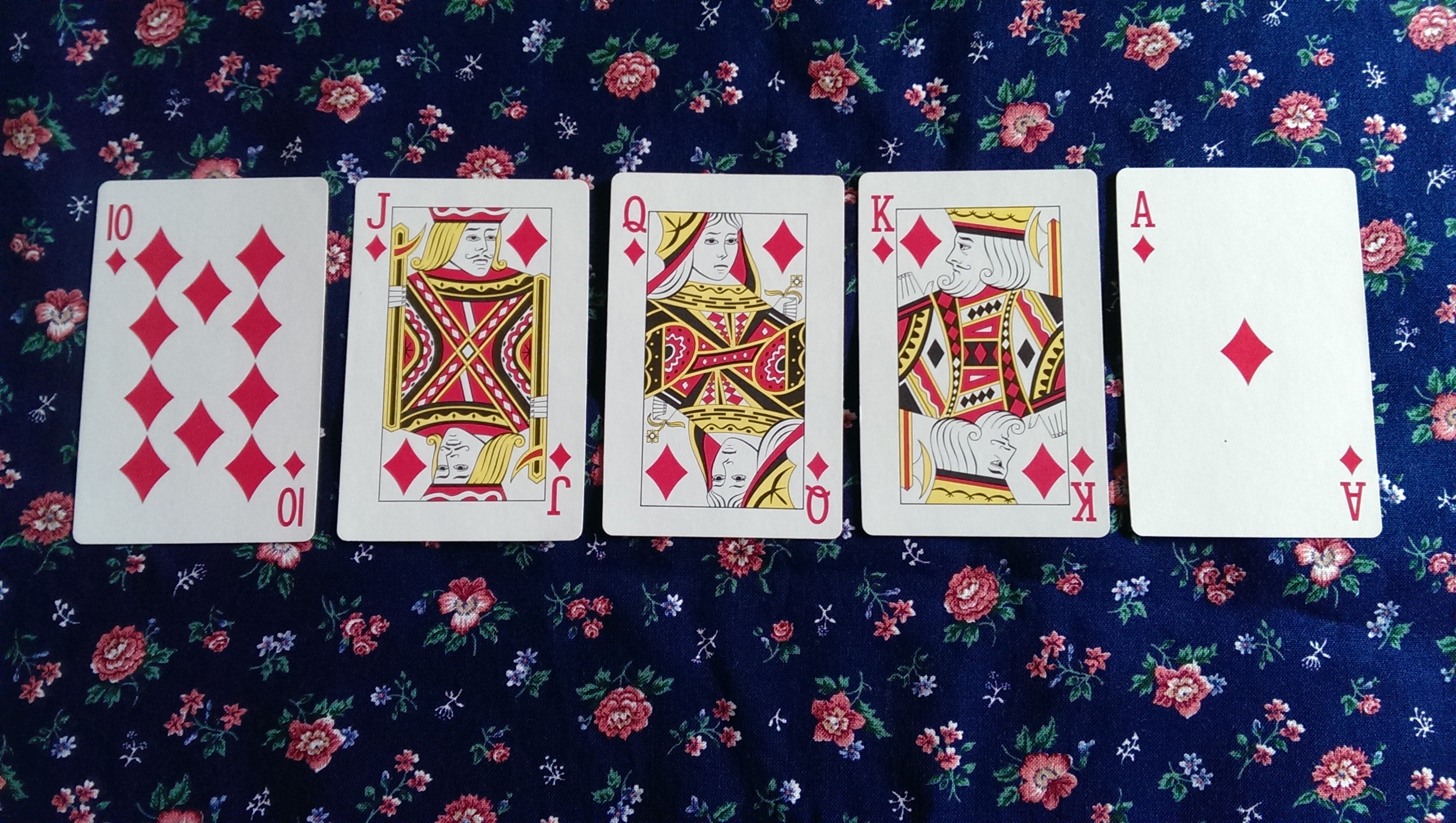
Royal Flush: This hand is made of the five highest-ranking cards in numerical order (10, jack, queen king, and ace) in a single suit. The only hand that can possibly beat this is Five of a Kind, but those only exist if you're using wild cards. Otherwise, this is the highest-ranking hand possible.
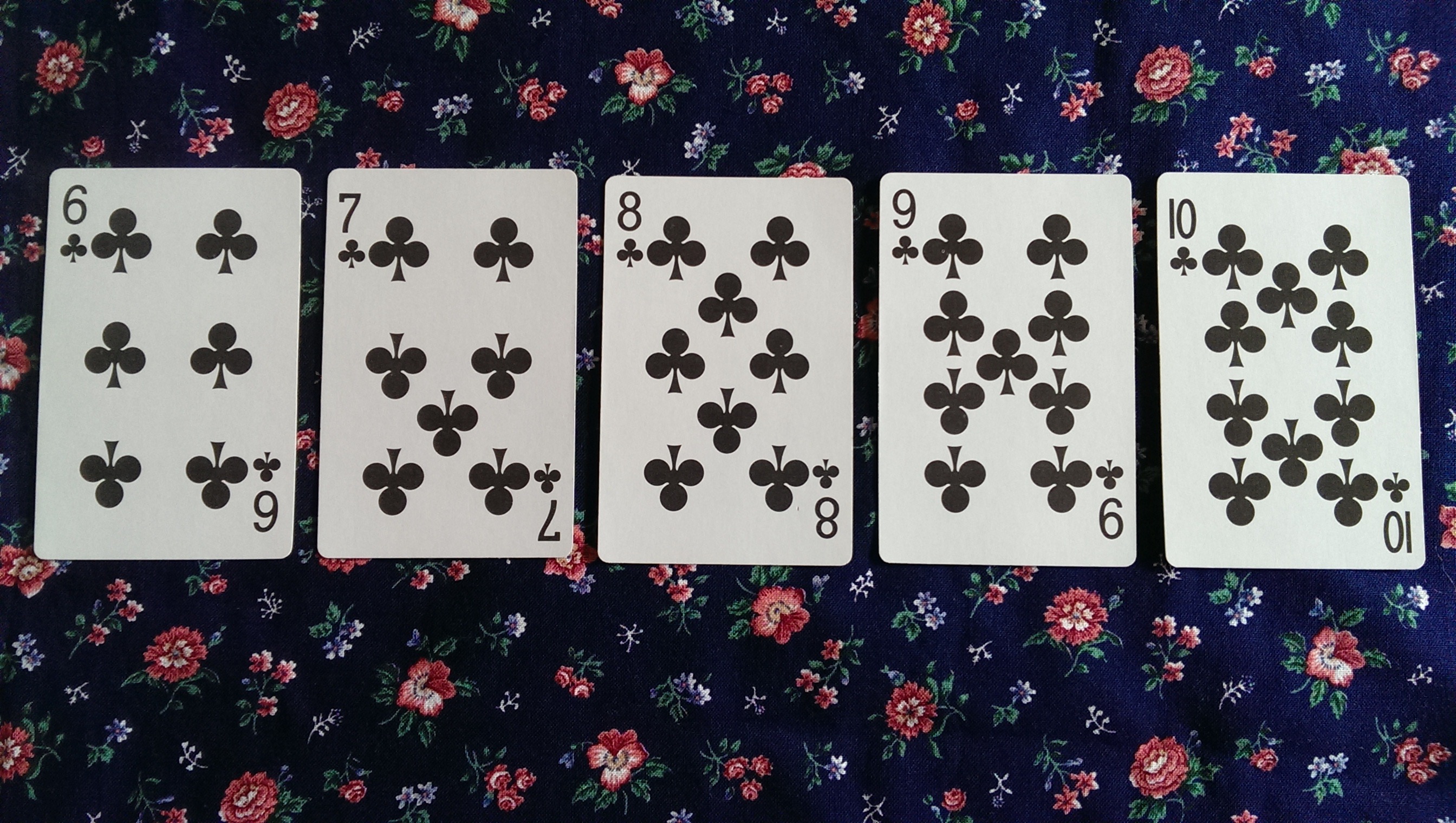
Straight Flush: This hand is made of five cards in numerical order. All cards must be in the same suit. If the values of the cards are the five highest (10, jack, queen, king, and ace), it is a Royal Flush.
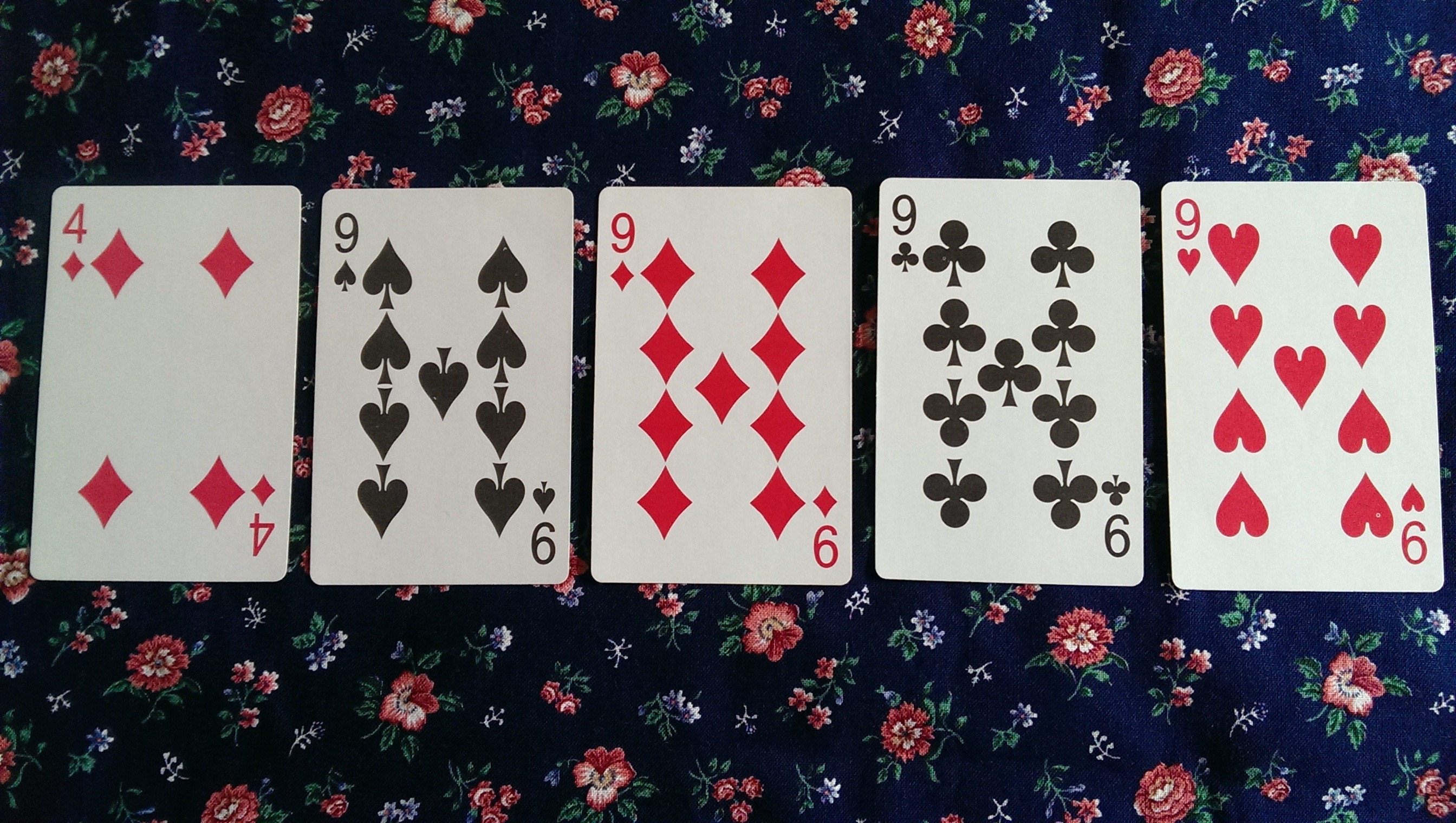
Four of a Kind: This hand is made of four cards of the same value accompanied by one other card of any value. If more than one person has four of a kind, the set of four with the highest-ranking value wins over the others. Four aces is the highest-ranking four of a kind possible.
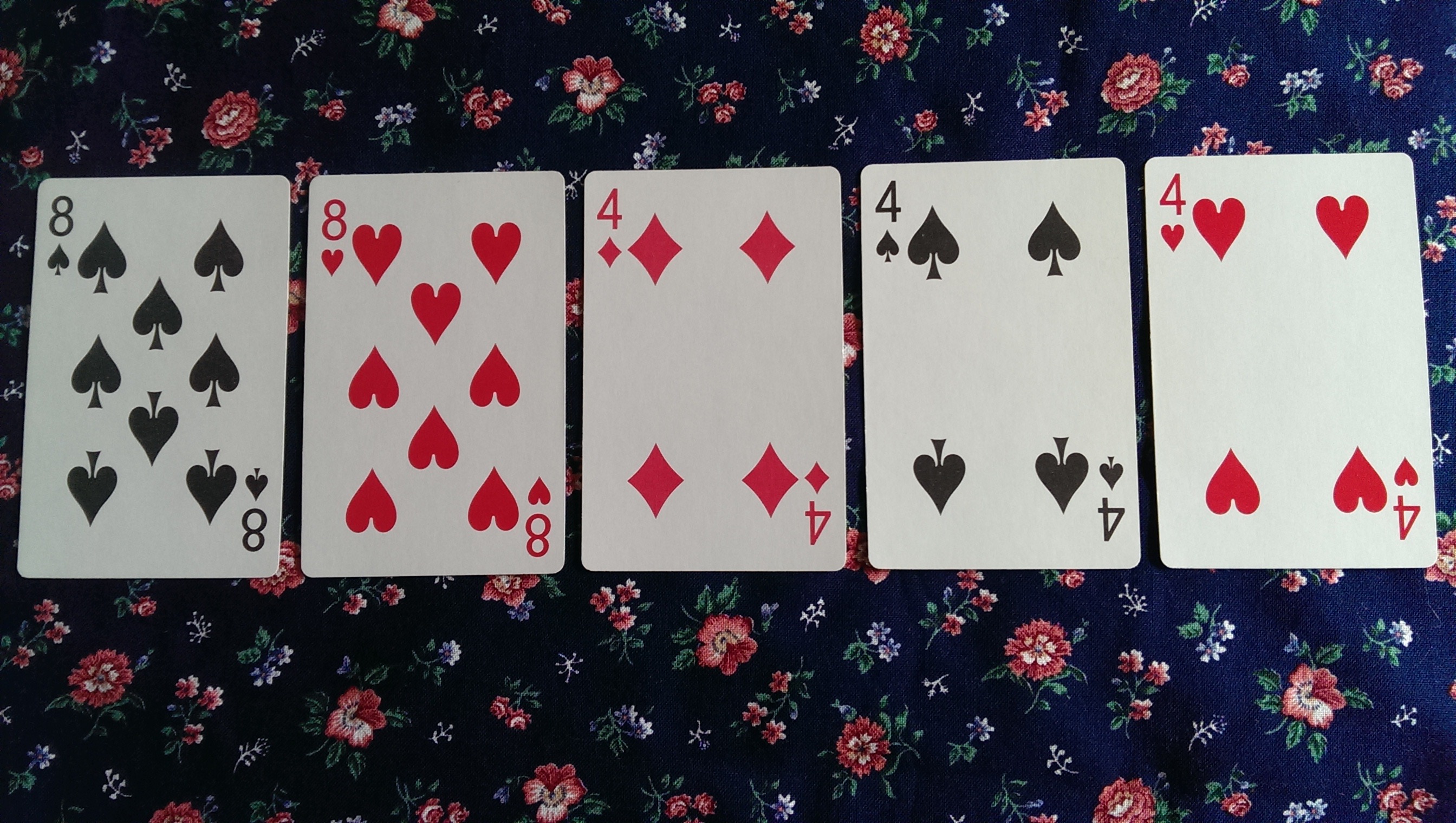
Full House: This hand is made of three cards of the same value accompanied by two matching cards of another value. You can think of this as three of a kind and a pair in one hand. If more than one person has a full house, the one with the highest value set of three wins.
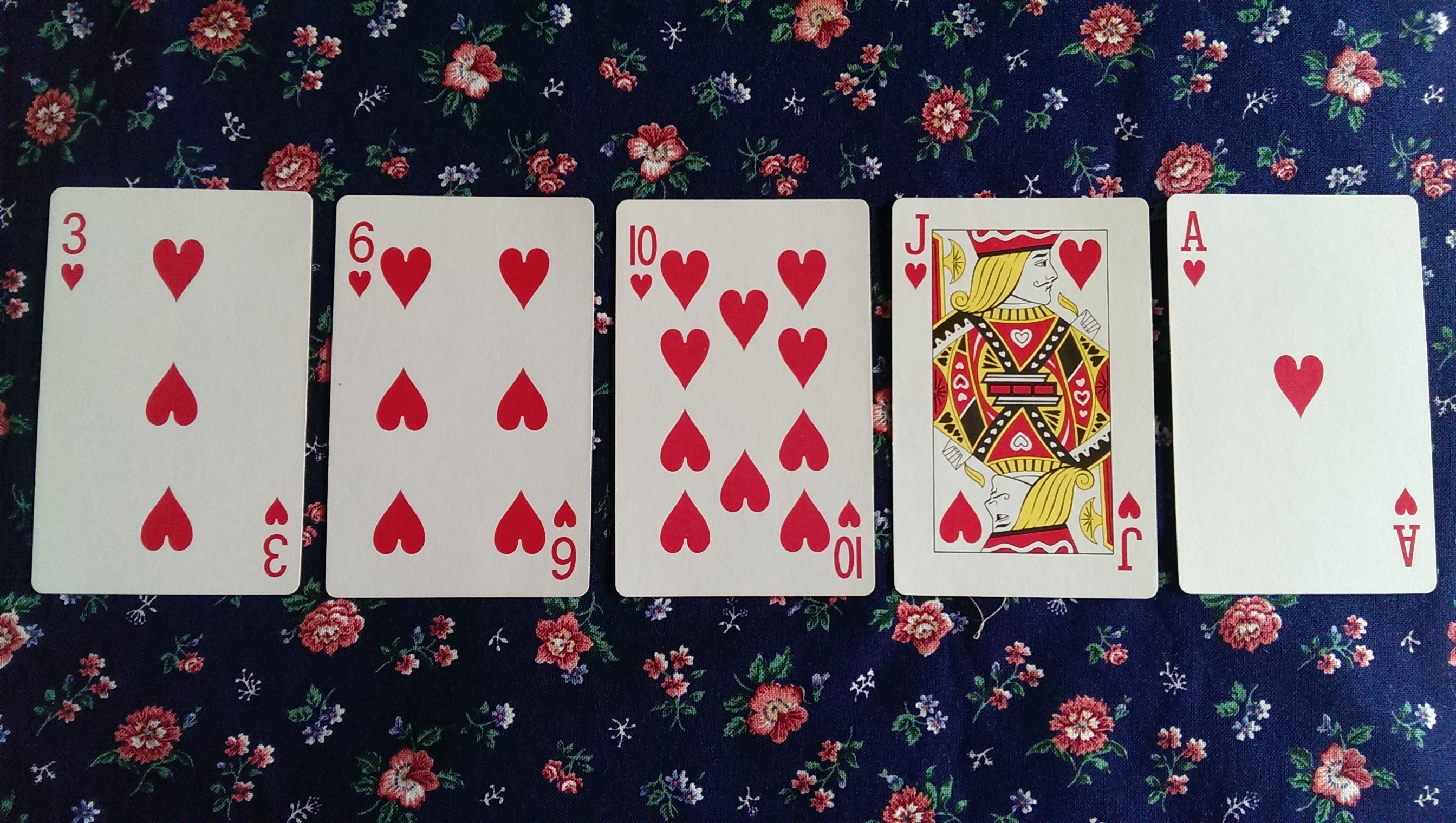
Flush: This hand is made of five cards of any value but all from the same suit. If the five cards are in numerical order, it is a Straight Flush. If more than one person has a flush, the one with the highest-ranking card in their hand is the winner. If there is still a tie for the highest-ranking card (for instance, if two players have a flush with an ace as the highest card in each of their hands), look at the next-highest ranking card in each hand to determine the winner.
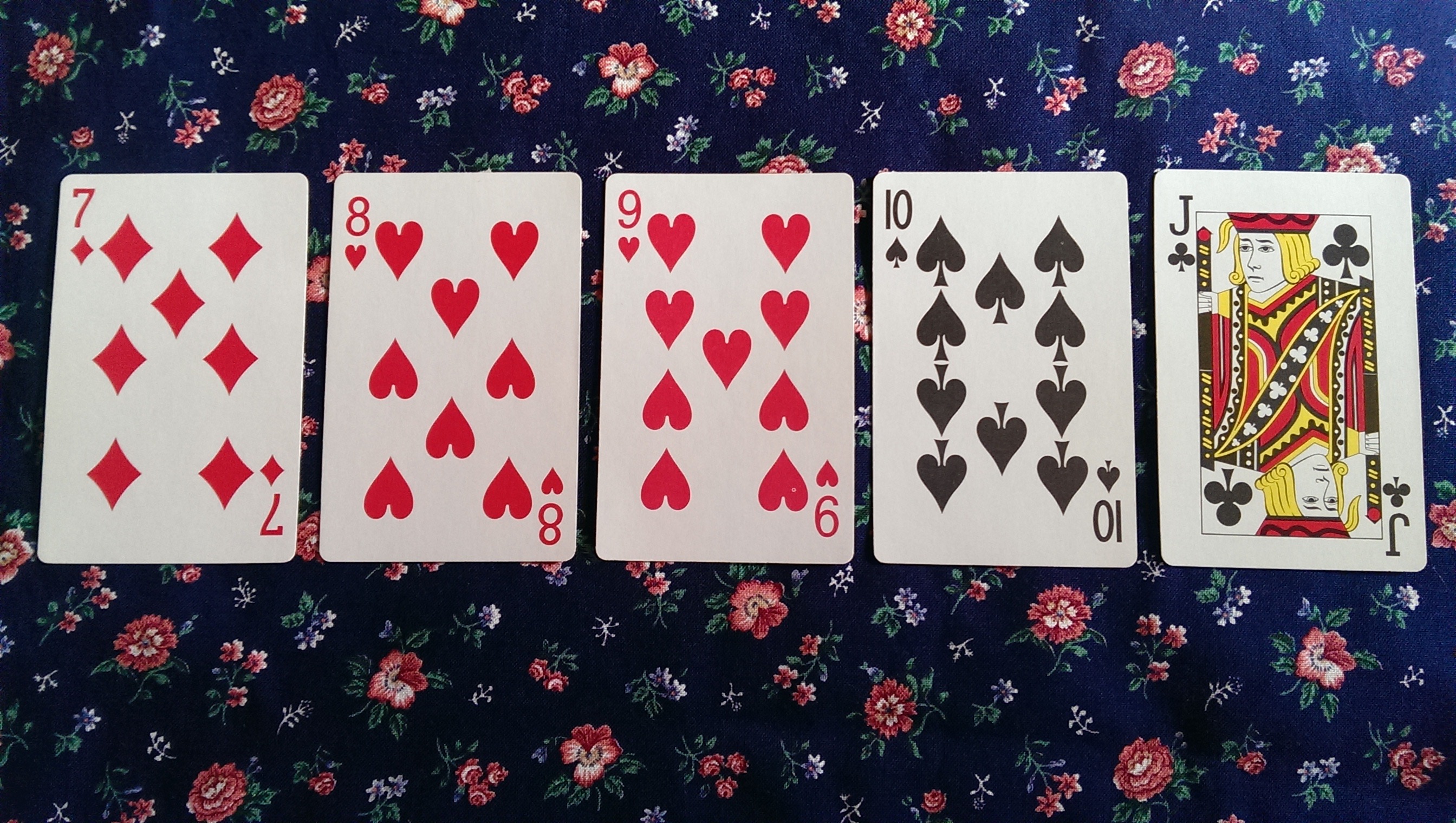
Straight: This hand is made of five cards in numerical order, but the cards may be from any combination of suits. A Broadway Straight is one with an ace as the highest card, and it is the highest-ranking straight. If more than one person has a straight, the one with the highest-ranking cards wins.
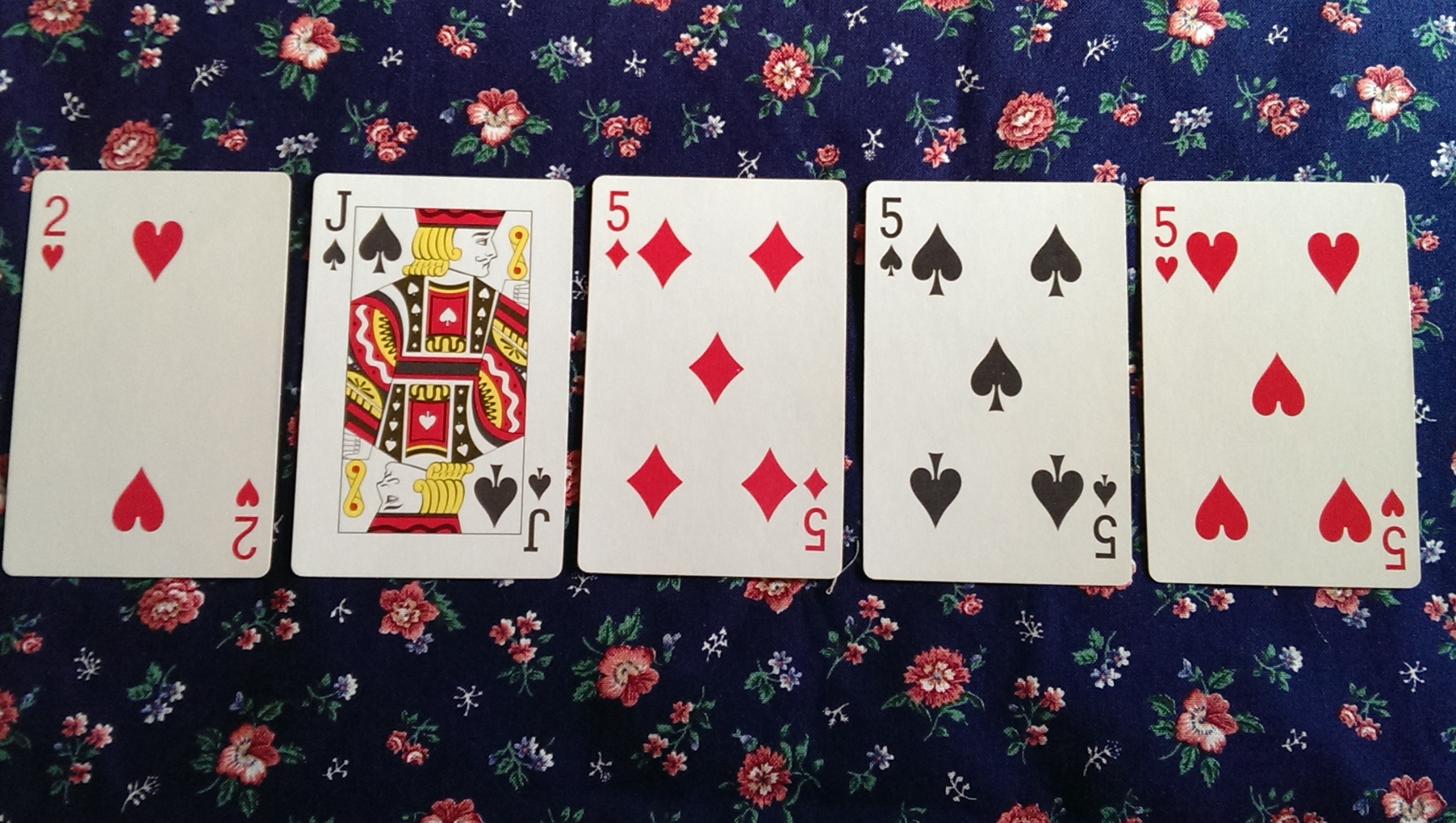
Three of a Kind: This hand is made of three cards of the same value accompanied by two other cards of any two other values. If more than one person has three of a kind, the winner is the one with the highest-ranking set of three.
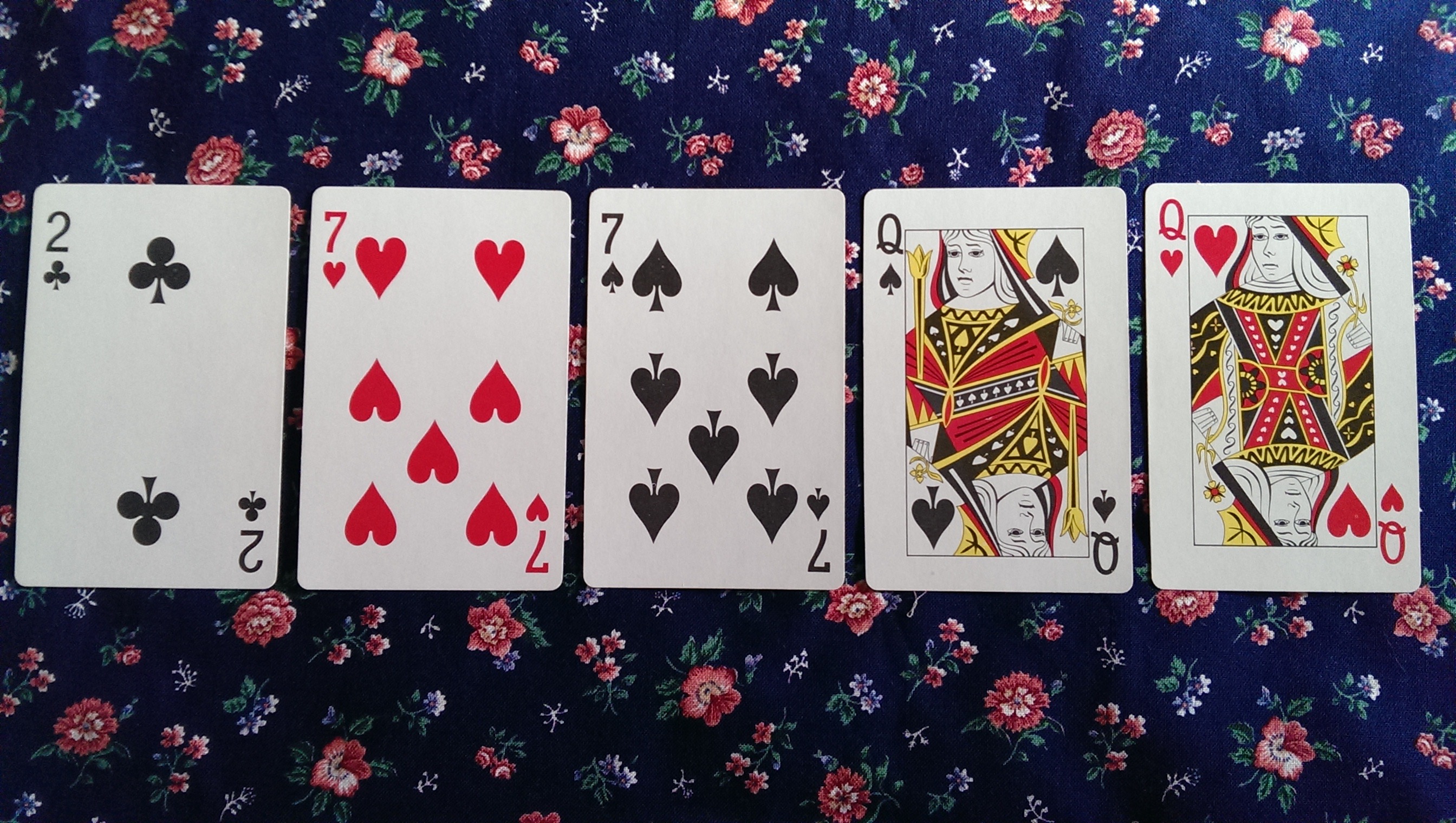
Two Pairs: This hand is made of one pair of cards with the same value, another pair with a different value, and one other card of a third value. If more than one person has two pair, the winner is the one with the pair with the highest value. If the highest-ranking pair in each hand is the same, the value of the second pair determines the winner. If both pairs in both hands are the same, the value of the fifth card in each hand determines the winner.
One Pair: This hand is made of one pair of cards with the same value and three cards of three other values. If more than one person has one pair, the winner is the one with the highest-ranking pair. If the pairs are tied for value, the winner is the one with the highest-ranking card among the other three cards in each hand.

High Card: If every player has a hand that doesn't match any of the above -- where the cards are not in numerical order, there are no cards matching in value, and the cards are from different suits -- the winning hand is determined by the highest ranking card in the players' hands. (Ex. If one player's highest card is an ace, and another player's highest-ranking card is a ten, the one with the ace wins.) If players are tied for the highest-ranking card, compare the next-highest-ranking card in each hand to determine the winner (and so on, if there's a tie for next-highest-ranking). (Ex. If two players each have an ace in their hand, check the next-highest-ranking card. If one of them has a queen and the other has a ten, the one with the queen wins.) Suits make no difference in judging the ranking.

